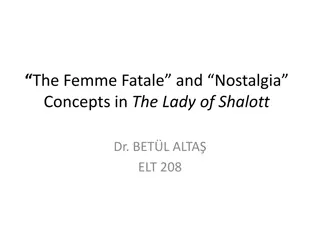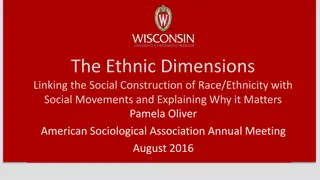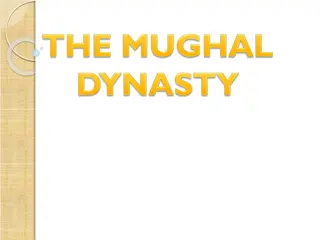Last of the Mohicans: Race, Empire, Romance, and Nostalgia
In "Last of the Mohicans," set during the French and Indian War, the story follows Cora and Alice Munro, daughters of Lieutenant Colonel Munro, as they encounter dramatic events involving betrayal, captivity, and rescue. The plot unfolds with struggles between British forces, Native Americans, and French soldiers, delving into themes of love, sacrifice, and the clash of cultures.
Download Presentation

Please find below an Image/Link to download the presentation.
The content on the website is provided AS IS for your information and personal use only. It may not be sold, licensed, or shared on other websites without obtaining consent from the author.If you encounter any issues during the download, it is possible that the publisher has removed the file from their server.
You are allowed to download the files provided on this website for personal or commercial use, subject to the condition that they are used lawfully. All files are the property of their respective owners.
The content on the website is provided AS IS for your information and personal use only. It may not be sold, licensed, or shared on other websites without obtaining consent from the author.
E N D
Presentation Transcript
Last of the Mohicans Race, Empire, Romance and Nostalgia
The plot of the novel Set during the French and Indian War, but of course he has to make it more dramatic and more romantic French and Indian War (1754 63) was the North American theater of the worldwide Seven Years' War of 1756 63 between the American colonies and New France (Canada). Cora and Alice Munro, daughters of Lieutenant Colonel Munro, travel to Fort William Henry, where Munro is in command. They are guided first by Magua (resentful Indian who leads them astray) then Hawk-eye, a scout for the British, and his two Mohican friends, Chingachgook and his son Uncas. They are attacked, and Hawk-eye and the Mohicans fight until their ammunition is exhausted. Hawk-eye and the Mohicans escape, with a promise to return for their companions. Magua and the Hurons capture the Munro sisters Magua is seeking revenge against Cora's father Colonel Munro. He then offers to spare the party if Cora becomes his wife, but she refuses. Upon a second refusal, he sentences the prisoners to death. Hawk-eye and the Mohicans rescue all four.
Plot continued . . . Hawk-eye leads the rescued party to Fort Henry, past a siege by the French army. Munro can t get reinforcements, so he agrees to leave with his wounded, women, and children. They are supposed to have a safe retreat, but outside the fort, the column of British prisoners is attacked by Huron warriors In the battle, Magua kidnaps Cora and Alice (again!) After the massacre, Hawk-eye, the Mohicans, and Colonel Munro follow Magua. They encounter a band of Hurons and Hawkeye is captured. There s a canoe chase, a torture scene where Hawkeye withstands it all without blinking, and many other standard elements of the adventure genre. After many convolutions, Alice (the blonde, conventional girl) is rescued, and Cora (the darker, more adventurous) dies. Magua and Uncas (the last Mohican) are killed. The novel concludes with the funerals of Uncas and Cora, and Hawk-eye reaffirms his friendship with Chingachgook. A Native leader at the end of the book prophesies: "The pale-faces are masters of the earth, and the time of the red-men has not yet come again....".
Romance: love heals all? Romance is (often in literature) a way to engage national/ideological conflicts and work them out on a emotional level. Example: Gone with the Wind takes on divisions within the south (new and old south) and uses love to make us want those things to come together. Desire is repurposed for political ends. In The Last of the Mohicans, the love between Hawkeye and Cora would be a bridge between the frontier and the East Coast aristocrats. Notice that the desire of Magua is always impossible, always portrayed as barbaric Notice that a homosocial bond endures (frontiersman and Indian) and a bond between 2 blond East Coast aristocrats. If anything, the novel ends more racially and politically polarized than it began
Romance as Allegory Definition: an Allegory is a comparison that is sustained throughout the whole of a work, or in a long section. As a comparison, it s the largest Metaphor/similie = sentence level Symbol = recurring or sustained for much of the work Allegory = every move the story makes (characters, events) works to develop another narrative logic, usually on a moral, political or philosophical level. First allegories were morality plays where a character would be named for it s role in the allegorical plot. Someone named Virtue would meet someone named Temptation, etc. Romance uses a love plot to show what happens when two sides of a problem try to come together. One way to read Cooper as an allegory: Frontier and Civilization want to get married, but it s impossible. Civilization can borrow from Frontier, but Frontier can never really enter Civilization. We can also do this in a more racially specific way . . . (Native and European)
Cooper on Race: sympathetic but . . . Hawkeye and Chingachgook engage in a debate about whether there s anything worse in white people s destruction of Indians and the history of Indian wars over control of territory. This seems to be a debate between equals Hawkeye speaks in Chingachgook s language Hawkeye s dress marks him as a person who is mixed culturally, even while he insists every few pages that he is not racially mixed. Hawkeye criticizes his own culture My own people have many ways, of which , as an honest man, I can t approve (532) He admits the truth of many things Chingachgook says Yields to Chingachgook s superior wisdom of not giving away their location with a gun shot to kill a deer. Other examples? But there is never any possibility of integration, marriage between races, or true social equality.
Imperialist Nostalgia Term coined by Renato Rosaldo in 1989 to describe the dominant culture s sadness at the destruction of a culture they are in the process of destroying. Nostalgia looks back with longing and rose colored glasses at what we can never have again Imperialist nostalgia participates in imperialism by helping us feel that we re not bad because we love those noble savages. It convinces us on an emotional level that it s inevitable. Its function is to erase the dominant culture s agency in the destruction of another culture, to blur that violence and responsibility with a warm fuzzy eraser: But we love the Indians! The ideas that the Indians always lived in harmony with nature, that they were more noble and spiritual as a race, and the assumption that they are now gone, all participate in this ideology, which is still alive in America.























